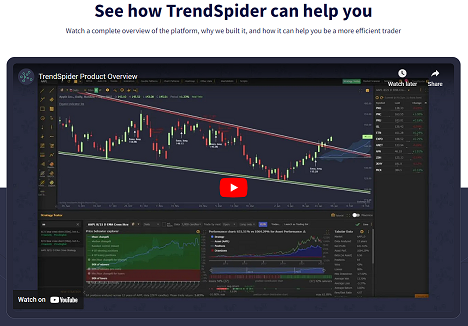
Technical Analysis Strategies by Trend Spider
Technical analysis is a popular approach used by traders and investors to analyze and make decisions based on price charts and other technical indicators. In contrast to fundamental analysis, which focuses on the underlying financial and economic factors that affect the value of an asset, technical analysis seeks to identify patterns and trends in price movements that can provide insights into future price movements.
In this article, we will explore some of the most popular technical analysis strategies that traders and investors use to make decisions.
Popular Technical Analysis Strategies
Below are brief descriptions of some of the most popular technical analysis strategies grouped into categories including momentum, volatility, and more. It is important to note that some of these strategies can fit into multiple categories.
Momentum Strategies
Momentum Oscillator Strategies: This strategy involves using momentum oscillators such as the Relative Strength Index (RSI) or Stochastic Oscillator to identify potential trading opportunities. Traders may use the overbought or oversold conditions identified by these indicators to enter or exit trades.
RSI Strategies: The Relative Strength Index (RSI) is a technical indicator used to measure the strength of a security by comparing its average gains to its average losses over a certain period. RSI strategies involve using the RSI to identify overbought and oversold conditions and using these signals to trade.
MACD Strategies: This strategy involves using the Moving Average Convergence Divergence (MACD) indicator, which measures the difference between two moving averages, to identify potential trading opportunities. Traders can use the MACD to confirm trends and identify potential reversals.
On-Balance Volume Strategies: This strategy involves using the on-balance volume (OBV) indicator, which measures the cumulative buying and selling pressure of a security, to identify potential trading opportunities. Traders can use the OBV to confirm trends and identify potential reversals.
Money Flow Index Strategies: This strategy involves using the money flow index (MFI) indicator, which measures the buying and selling pressure of a security, to identify potential trading opportunities. Traders can use the MFI to identify overbought and oversold conditions.
Volatility Strategies
Bollinger Band Strategies: This strategy involves using Bollinger Bands, which is a technical indicator that uses a moving average and standard deviations to determine the upper and lower boundaries of a price range. Traders can use these boundaries to determine potential entry and exit points.
Donchian Channel Strategies: This strategy involves using the Donchian Channel, a technical indicator that identifies the highest high and lowest low over a certain period, to identify potential trading opportunities. Traders can use the channel boundaries to determine potential entry and exit points.
Trend-Following Strategies
Chart Pattern and Trendline Strategies: This strategy involves using trendlines and chart patterns to identify potential trading opportunities. Chart patterns such as triangles, head and shoulders, and double tops can signal potential price movements.
Ichimoku Cloud Strategies: This strategy involves using the Ichimoku Cloud, a technical indicator that provides multiple levels of support and resistance, to identify potential trading opportunities. Traders can use the levels of the cloud to determine entry and exit points.
Moving Average Crossover Strategies: This strategy involves using two or more moving averages of different periods and using the crossover of these averages to determine entry and exit points for trades.
Time-Weighted Average Price (TWAP) Strategies: This strategy involves executing trades over a specific time period to achieve a weighted average price. Traders may use TWAP to minimize the impact of large trades on the market and avoid moving the price of the security.
Seasonality Strategies: This strategy involves analyzing historical patterns in market behavior to identify potential trading opportunities. Traders can use seasonality to anticipate potential price movements during specific times of the year, month, week, day, etc.
Event-Driven Strategies
Analyst Estimate and Rating Strategies: This strategy involves using analyst estimates and ratings to identify potential trading opportunities. Traders may use analyst estimates and ratings to determine the expected performance of a security.
Corporate Insider Trading Activity Strategies: This strategy involves analyzing the buying and selling activity of corporate insiders to identify potential trading opportunities. Traders may look for significant purchases or sales by insiders to identify potential price movements.
Unusual Options Activity Strategies: This strategy involves analyzing unusual options activity to identify potential trading opportunities. Traders may look for significant increases in trading volume or changes in open interest to identify potential price movements.
Earnings Report Strategies: This strategy involves analyzing the earnings reports of companies to identify potential trading opportunities. Traders may look for significant surprises or changes in earnings to identify potential price movements.
Volume Strategies
Volume Profile Strategies: This strategy involves using the volume of a security at different price levels to identify potential trading opportunities. Traders can use the volume profile to determine levels of support and resistance and potential entry and exit points.
Relative Volume (RVOL) Strategies: This strategy involves using the volume of a security relative to its average volume to identify potential trading opportunities. High RVOL may indicate a potential price movement, while low RVOL may indicate a lack of interest in the security.
Anchored VWAP Strategies: This strategy involves using the volume-weighted average price (VWAP) and anchoring it to a specific point in time to identify potential trading opportunities. Traders may use the anchored VWAP to determine entry and exit points.
Accumulation/Distribution (A/D) Strategies: This strategy involves using the A/D line, a technical indicator that measures the buying and selling pressure of a security, to identify potential trading opportunities. Traders can use the A/D line to confirm trends and identify potential reversals.
Other Strategies
Price Action Strategies: This strategy involves analyzing the price movements of a security to identify potential trading opportunities. Traders may use candlestick patterns, support and resistance levels, and other technical analysis tools to identify potential entry and exit points.
Candlestick Pattern Strategies: This strategy involves analyzing candlestick patterns on a chart to determine entry and exit points for trades. Candlestick patterns provide insight into the psychology of the market and can be used to identify potential reversals or continuations.
Gap Fill Strategies: This strategy involves trading gaps that occur when there is a difference between the closing price of a security and its opening price the next period.
Fair Value Gap Strategies: This strategy involves identifying inefficiencies in the market and trading based on the assumption that prices will be pulled toward the gaps to clear out the inefficiencies before continuing a trend.
Mean Reversion Strategies: This strategy involves trading based on the belief that prices will eventually revert to their mean or average value. Traders may use technical indicators such as Bollinger Bands or moving averages to identify overbought or oversold conditions and potential opportunities to trade mean reversion.
TheStrat Strategies: This strategy uses a combination of technical analysis, market psychology, and risk management. Unlike traditional trading strategies that rely on complex mathematical models and algorithms, #TheStrat is more intuitive and flexible, allowing traders to adapt to changing market conditions in real-time.
Overall, there are a wide variety of trading strategies available to traders, each with its own set of advantages and disadvantages. Successful traders may use a combination of different strategies and tools to make informed trading decisions and maximize their profits while minimizing their risks. It is important for traders to carefully consider their own risk tolerance, trading goals, and market conditions before choosing a specific trading strategy.
The Bottom Line
In conclusion, technical analysis is a powerful tool that can help traders and investors make informed decisions. By analyzing historical market data, traders can identify patterns and trends that can help predict future price movements. While there are many technical analysis strategies available, it is important to choose a strategy that aligns with your goals and risk tolerance.
Whether you are a seasoned trader or just starting out, incorporating technical analysis into your strategy can help increase your chances of success in the ever-changing world of finance. As with any strategy, however, it is important to thoroughly research and understand the risks involved before making any trades.

